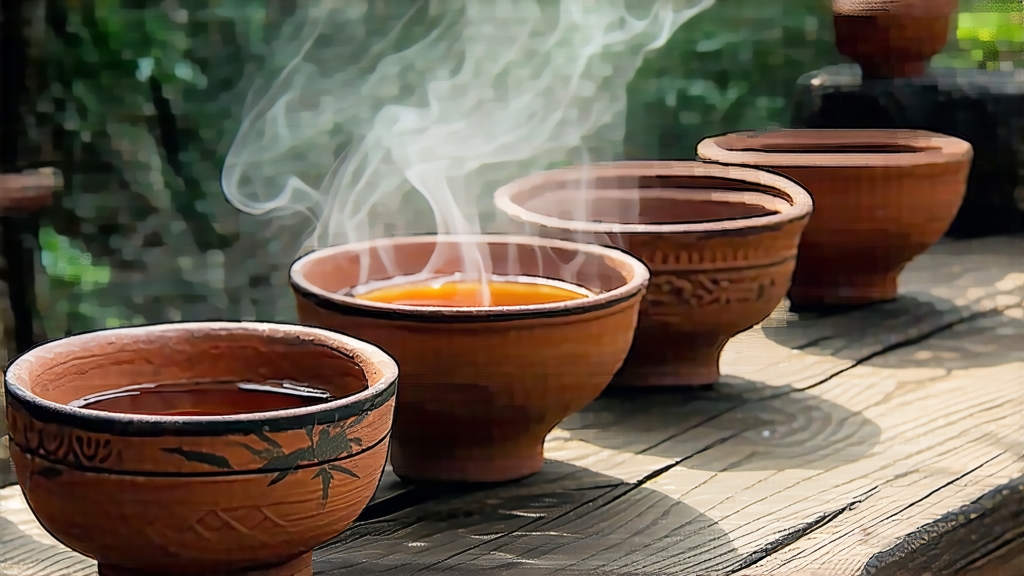
Tucked away in the subtropical hills of Guangxi Province, where the Xun and Gui Rivers braid through karst peaks veiled in perpetual mist, lies the cradle of one of China’s least-known yet most captivating dark teas: Liu Bao. To the casual observer the name may sound unfamiliar, yet for three centuries this tea financed the caravan trails that fed the Qing empire’s frontier garrisons, perfumed the incense-filled tea houses of Hong Kong dockworkers, and still steams quietly in the clay kettles of the Zhuang and Yao minorities. Unlike the loamy richness of Yunnan Pu-erh or the horse-stable nostalgia of Hunan Fu Brick, Liu Bao carries the cool, resinous breath of camphor forests and the mineral echo of limestone caves. It is a tea that ages not into heaviness but into clarity, turning time itself into a kind of mountain water.
Historical footprints
The earliest written record appears in 1797, in the county gazetteer of Cangwu: “Dark leaf from Liu Bao village, bartered for salt and iron, travels west with the grain boats.” By the late nineteenth century the tea had become a currency along the Pearl River delta; compressed baskets weighing exactly 37 kilograms—still the standard today—were accepted as tax payment by the Qing customs office at Wuzhou. When the British opened their treaty port there in 1897, Liu Bao sailed to Singapore and Kuala Lumpur, where tin-mine coolies prized it for dissolving the pork fat that coated their rice plates. During the Pacific War the Japanese occupation cut off Pu-erh supply; Liu Bao filled the vacuum, and Hong Kong tea masters learned to mimic the humid storage of Guangxi river warehouses, giving birth to the “traditional stored” style that connoisseurs now chase at auction.
Micro-terroirs and leaf styles
Liu Bao is not a single cultivar but a mosaic of landraces rooted in three micro-zones. The highest, Liudong, grows tea at 600–800 m among wild camphor trees; the leaf is small, orchid-shaped, and high in borneol, yielding a liquor that finishes with a cool, almost menthol snap. The middle zone, around the market town of Dazhong, offers broader leaves from the Baiye cultivar, richer in polyphenols and ideal for the wet-piling process. The lowest terrace, along the river port of Xinxu, supplies the raw bulk once destined for basket compression. Within these zones farmers distinguish three plucking standards: yi ya (single bud), zhong kai (standard two-leaf), and lao ye (mature three-leaf) reserved solely for post-fermentation. Each responds differently to the cave microbes that will later sculpt the tea’s personality.
From leaf to basket: the craft sequence
Harvest begins at Qingming when the mountain mist lifts just enough to reveal the purple flush of new buds. The leaves are solar-withered on split-bamboo trays for three hours, turned every twenty minutes to coax grassy volatiles out without bruising the cell walls. A 3-minute 280 °C pan-fire follows, hot enough to kill green enzymes yet brief enough to preserve the leaf’s spine for repeated re-rolling. Rolling is done in 5 kg batches on horse-hair mats; the master’s forearms press downward in a spiral, releasing a faint snap of camphor as the cellular sap meets air. After a second, lower-temperature firing the leaves are left overnight to “return to life”—a short oxidative rest that softens edges before the defining step: wet piling.
Unlike Pu-erh’s wo dui, Liu Bao’s dui cha is gentler and shorter, a 10- to 18-day choreography moderated by the cave itself. Workers build 1.2-metre piles inside sandstone grottoes where year-round humidity hovers at 88 % and temperature at 24 °C. Every two days the pile is sprayed with mountain water filtered through quartz sand, then forked to introduce oxygen. Indigenous microbes—Bacillus subtilis, Aspergillus niger, and a rare Wallemia strain—thrive on the camphor-rich leaf wax, metabolising bitter catechins into the mellow pigment thefu. When the core temperature reaches 46 °C the pile is dismantled, and the tea is sun-dried on river pebbles that reflect